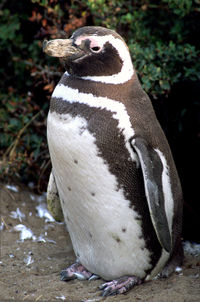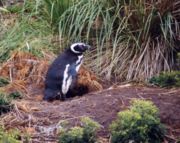Magellanic Penguin
2007 Schools Wikipedia Selection. Related subjects: Birds
| iMagellanic Penguin | ||||||||||||||
|---|---|---|---|---|---|---|---|---|---|---|---|---|---|---|
 |
||||||||||||||
|
|
||||||||||||||
| Scientific classification | ||||||||||||||
|
||||||||||||||
|
|
||||||||||||||
| Spheniscus magellanicus ( Forster, 1781) |
The Magellanic penguin (Spheniscus magellanicus) is a South American penguin, breeding in coastal Argentina, Chile and the Falkland Islands, with some migrating to Brazil. It is the most numerous of the Spheniscus penguins. Its nearest relatives are the African Penguin, the Humboldt Penguin and the Galápagos Penguin.
Appearance
Magellanic Penguins are medium-sized, black and white penguins, growing 70-76 cm tall. They have a black head with a broad white border running from behind the eye, around the black ear-coverts and chin, to join on the throat. They have blackish-grey upperparts and whitish underparts, with two black bands between the head and the breast, the lower in an inverted horseshoe shape.
Diet
Magellanic penguins feed in the water, preying on cuttlefish, sardines, squid, krill, and other crustaceans. They drink sea water, filtering out the salt with their salt excreting glands
Behaviour & Reproduction
Magellanic penguins travel in large flocks when hunting for food. In the breeding season, these birds gather in large nesting colonies at the coasts of Argentina, Southern Chile, and the Falkland islands, having 20 nests per 100 square meters. Nests are built under bushes, or in burrows. Two eggs are laid and often both and sometimes only one is raised through adulthood. Two eggs are laid and often both and sometimes only one is raised through adulthood. Incubation lasts 39-42 days in 10-15 day shifts, and the chicks are cared for by both parents for 29 days, and fed every 2-3 days. These birds are very shy on land and hide in their nests while on shore.
Status in the Wild
Millions of these penguins still live on the coasts of Chile and Argentina, but the main threats to these species are the vulnerability of large breeding colonies to oil spills which kill 20,000 adults and 22,000 juveniles every year off the coast of Argentina. The decline of fish populations are also responsible, as well as predators including sea lions and giant petrels which prey on the chicks.

